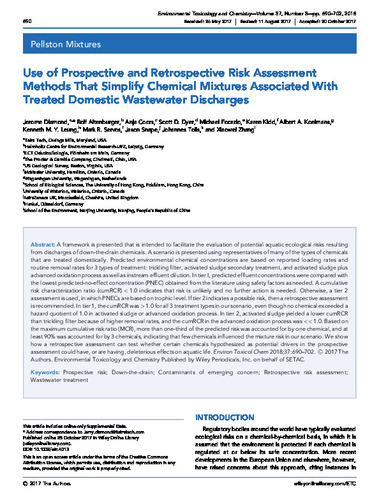| dc.contributor.author | Diamond, Jerome | |
| dc.contributor.author | Altenburger, Rolf | |
| dc.contributor.author | Coors, Anja | |
| dc.contributor.author | Dyer, Scott D. | |
| dc.contributor.author | Focazio, Michael | |
| dc.contributor.author | Kidd, Karen A | |
| dc.contributor.author | Koelmans, Albert A. | |
| dc.contributor.author | Leung, Kenneth M. Y. | |
| dc.contributor.author | Servos, Mark R. | |
| dc.contributor.author | Snape, Jason | |
| dc.contributor.author | Tolls, Johannes | |
| dc.contributor.author | Zhang, Xiaowei | |
| dc.date.accessioned | 2022-06-20 21:06:39 (GMT) | |
| dc.date.available | 2022-06-20 21:06:39 (GMT) | |
| dc.date.issued | 2018-03-01 | |
| dc.identifier.uri | https://doi.org/10.1002/etc.4013 | |
| dc.identifier.uri | http://hdl.handle.net/10012/18409 | |
| dc.description.abstract | A framework is presented that is intended to facilitate the evaluation of potential aquatic ecological risks resulting from discharges of down-the-drain chemicals. A scenario is presented using representatives of many of the types of chemicals that are treated domestically. Predicted environmental chemical concentrations are based on reported loading rates and routine removal rates for 3 types of treatment: trickling filter, activated sludge secondary treatment, and activated sludge plus advanced oxidation process as well as instream effluent dilution. In tier I, predicted effluent concentrations were compared with the lowest predicted-no-effect concentration (PNEC) obtained from the literature using safety factors as needed. A cumulative risk characterization ratio (cumRCR) < 1.0 indicates that risk is unlikely and no further action is needed. Otherwise, a tier 2 assessment is used, in which PNECs are based on trophic level. If tier 2 indicates a possible risk, then a retrospective assessment is recommended. In tier 1, the cumRCR was > 1.0 for all 3 treatment types in our scenario, even though no chemical exceeded a hazard quotient of 1.0 in activated sludge or advanced oxidation process. In tier 2, activated sludge yielded a lower cumRCR than trickling filter because of higher removal rates, and the cumRCR in the advanced oxidation process was << 1.0. Based on the maximum cumulative risk ratio (MCR), more than one-third of the predicted risk was accounted for by one chemical, and at least 90% was accounted for by 3 chemicals, indicating that few chemicals influenced the mixture risk in our scenario. We show how a retrospective assessment can test whether certain chemicals hypothesized as potential drivers in the prospective assessment could have, or are having, deleterious effects on aquatic life. | en |
| dc.language.iso | en | en |
| dc.publisher | Wiley | en |
| dc.rights | Attribution 4.0 International | * |
| dc.rights.uri | http://creativecommons.org/licenses/by/4.0/ | * |
| dc.subject | prospective risk | en |
| dc.subject | down-the-drain | en |
| dc.subject | contaminants of emerging concern | en |
| dc.subject | Retrospective risk assessment | en |
| dc.subject | wastewater treatment | en |
| dc.title | Use of prospective and retrospective risk assessment methods that simplify chemical mixtures associated with treated domestic wastewater discharges | en |
| dc.type | Article | en |
| dcterms.bibliographicCitation | Diamond, J., Altenburger, R., Coors, A., Dyer, S. D., Focazio, M., Kidd, K., Koelmans, A. A., Leung, K. M. Y., Servos, M. R., Snape, J., Tolls, J., & Zhang, X. (2018). Use of prospective and retrospective risk assessment methods that simplify chemical mixtures associated with treated domestic wastewater discharges. Environmental Toxicology and Chemistry, 37(3), 690–702. https://doi.org/10.1002/etc.4013 | en |
| uws.contributor.affiliation1 | Faculty of Science | en |
| uws.contributor.affiliation2 | Biology | en |
| uws.contributor.affiliation2 | Chemistry | en |
| uws.typeOfResource | Text | en |
| uws.peerReviewStatus | Reviewed | en |
| uws.scholarLevel | Faculty | en |


